The Qatar That’s Beyond the Scope of Doha and the World Cup
SEALINE BEACH, QATAR — I’m sitting on top of a camel.
It’s worth repeating. I’m sitting … on top of … a camel.
It sounds absurd, and yet, somehow, strangely, against all common sense and better judgment, it’s true. This camel’s hair is tan; its toenails, white with dark spots; its mask, knitted, mostly blue, with yellow-and-red trim. There’s a harness to grasp for balance and a feed bag resting atop the hump. I’m told by the friendly tour guides at Ali Camel Safari that they call their brood of 45 camels, informally, The Ships of the Desert. I guess that means I’m sailing but on sand.
It’s mid-morning here on Wednesday, and there’s only one reasonable question to float into the cosmos. How in the world did I end up here? Remember: I’m sitting on top of a camel, and this camel is being led by a man from Sudan, who I met only a few minutes earlier. And I only met him through a random encounter with a friendly taxi driver from India who talked me into a full day of exploration and insisted we stop here first, without any in-depth explanation of the whole camel-ride-in-the-desert plan.
There’s a story here, one born from an absurd, magical and, at times, uneasy 10 hours. It’s about this man, this day and this country—and what all three say about the World Cup. In some ways, those hours explain what soccer fans from all over the world can expect upon arrival. In others, they explain Qatar outside of Doha, its sprawling metropolis, the contrast evident in the country’s oldest known village, a historic fort, a fishing hub and miles upon miles traversed in my new friend Pradeep’s small white cab.
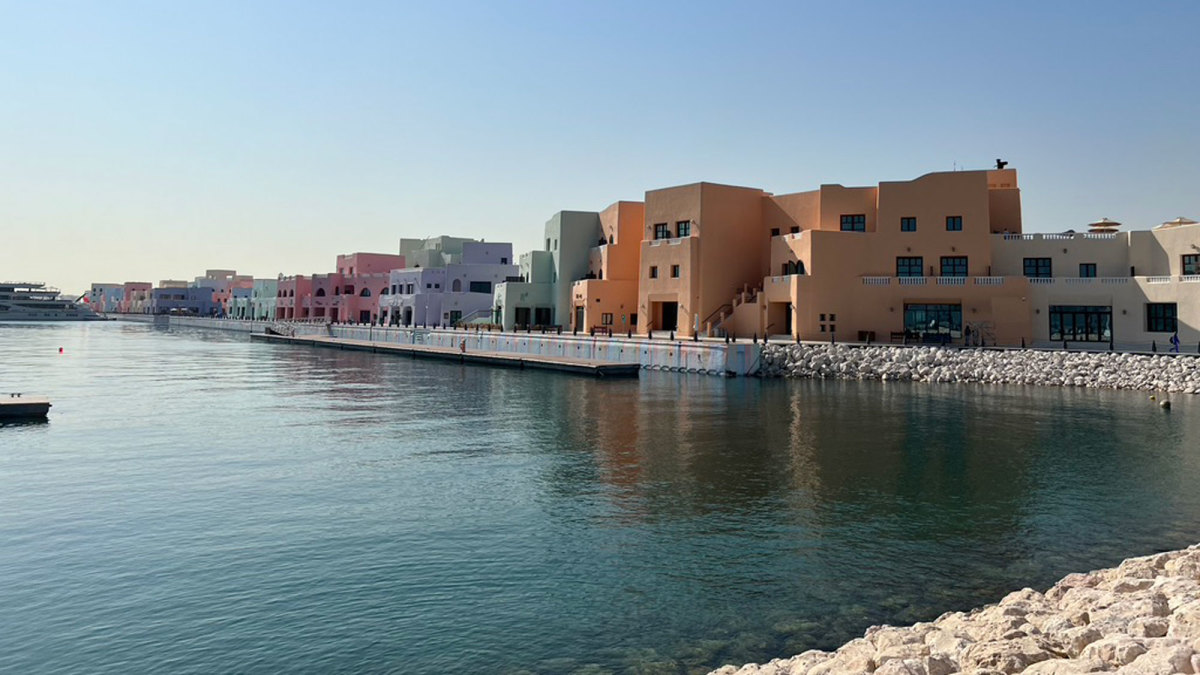
Let’s start at the beginning, on a cloudless, toasty Wednesday morning, en route to the Doha Port.
Ubers are plentiful here, available in a matter of minutes and super cheap compared to the U.S, with a 25-minute ride costing roughly $6. The driver of this particular Uber is from Pakistan, and he’s friendly, and while we pass a large, fancy building for the National Human Rights Committee, he’s asking why there’s so much fuss over this World Cup. I start to tell him about the migrant workers, thousands of whom died building these palatial stadiums; about the laws that take away rights for certain groups of people. He stops me midway through, with a dismissive wave. “This is our world here,” he says. “You want fair. Not how it works.”
The sentiment rings as sad but not untrue, and there’s no time and no desire to debate the cultural divide. We bank right, away from the street closed for all but official vehicles and fortified by a small army of security guards. This is the World Cup in Doha—high-rise luxury hotels, five-star restaurants and a clear dividing line between those who have much and everybody else. It’s Doha and its citizens that make this country, by some measures—like GDP per capita PPP, or gross domestic product, adjusted for purchasing power parity, by population—the richest in the world.
We stop at the old port of Doha, near a sign that says Mina District and all manner of stores—for yacht rentals, fine chocolates, gelato, designer threads imported from London and France, Italian food, flowers and frites. The water flowing from fountains fashioned in rock formations glistens in the mid-morning sun.
In the distance, two cruise ships rest on the opposite shore. They’re from Switzerland, and they’re docked here, near luxury yachts that are stunning in size, also here for the World Cup. Their cruise-ship cousins are floating hotels of sorts for the million or so visitors expected to descend on Doha who either cannot indulge in five-star prices or cannot find another lodging option. But their rooms are available only to the fortunate folks who have secured tickets to matches and must be booked through FIFA, through its system. The cheapest available ship rooms cost $320 a night, for now. (But alcohol is reportedly available on board!)
Workers are everywhere, same as throughout Qatar, and here the toilers are power-washing vessels, cleaning the docks and putting up signage. A bus stops, and another 30 or so get off to clock in for another long day.
My goal: to check out either the MSC Opera, the MSC World Europa and the MSC Poesia, three cruise ships from Geneva-based MSC Cruises’ fleet. On this morning, there are no signs of life beyond workers and a dozen security guards lining the fence near the ships. It’s quiet enough to hear birds chirping and pick up random snippets of chatter from workers a few hundred feet away.
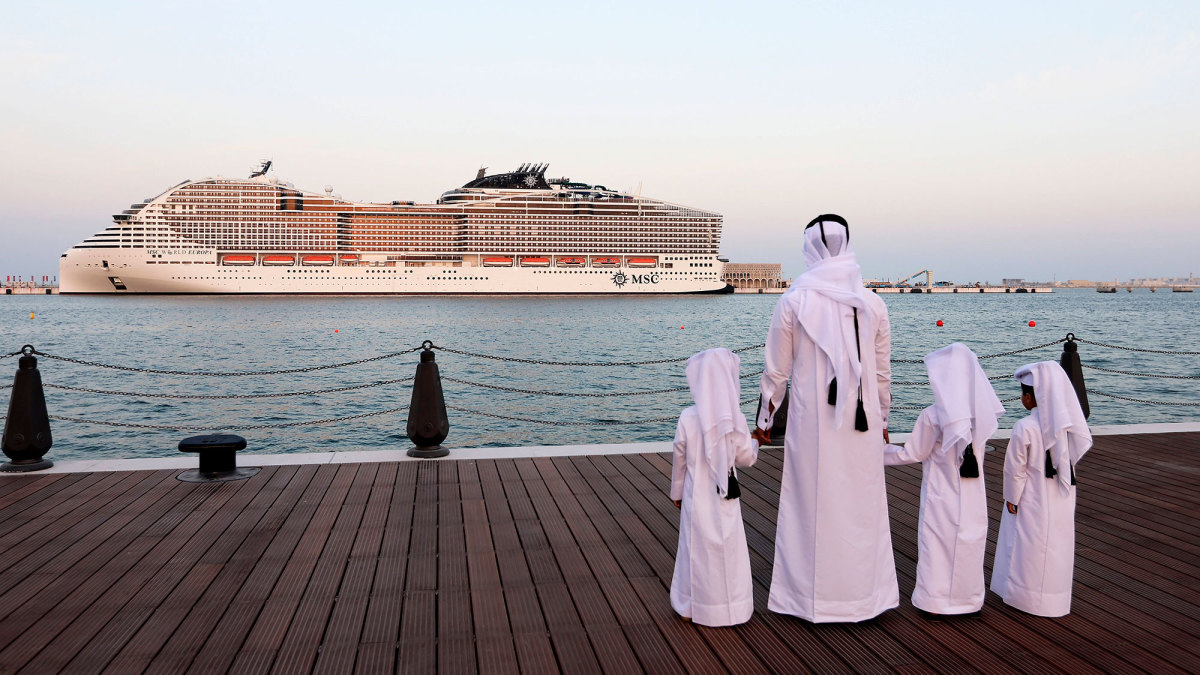
The Persian Gulf waters are stunning, colored a greenish-blue but also clear, due to calm waves. At the fence near MSC World Europa, a security guard jogs over. He’s smiling and introduces himself and says he’s from Nepal, a country where many of his countrymen helped build the World Cup stadiums. “A shame,” he says, and I assume he means the deaths and brutal conditions, but before I can ask, he pivots back into official mode. He says I need a ticket to look at one of the rooms and the rest of the ship. “You can purchase a night online,” he says, gesturing at this beast of a vessel, with its full-scale theater; pop-up art exhibits; the world’s longest at-sea dry slide, which drops from deck 20 to deck 8 and is known as The Venom Drop @ The Spiral; several pools, a water park; and an area for children complete with bumper cars, a rollerblade arena and video arcades.
“This,” the guard from Nepal says, “is one of the very finest hotels in all of Qatar.”
After some haggling, he agrees to take me aboard for a look. But as we walk toward the entrance, one of his supervisors spies us and shouts, “WAIT!”
He wags his finger like Dikembe Mutombo and says what people say often here, where privilege connotes a different life.
“This, sir,” the supervisor says, “is not for you.”
Mission aborted, detention avoided, I stumble back into the heat. A white cab pulls up alongside me, and I wave it off. But the driver circles back, then parks and walks toward me, extending a hand.
“Hello, sir. I am Pradeep.”
We make small talk. He came here from the southern part of India more than 11 years ago, leaving behind his wife and 9-year-old daughter. For two months every year, he travels back home to visit them. Otherwise, he lives in a cramped apartment with anywhere between one and six other drivers at different times. I tell him all the places I want to visit that day, for reporting about Qatar, and he says he will take me to all of them and more, for only a few hundred bucks. It seems, in some ways, like a tourist trap.
But the easy mark says yes. The driver hops back into his cab, hands over a one-liter bottle of water and says, “You need this. We will go everywhere you like. But first, we must head to the desert. When you go there, you will understand.”
The small talk continues on the drive south, away from the Doha maze. Pradeep says the wider sports universe will never before have seen a World Cup in a place this busy, this condensed. He says the venue in Al Khor, Al Bayt Stadium, site of Sunday’s opener between Qatar and Ecuador, is his favorite, for its authenticity and the long park that encircles the grounds. He shows me his match ticket, the one he saved up for. He’ll be inside for the final game of group play, Brazil-Cameroon. Then he asks the kind of question that can be asked only in places like this, between two strangers who hold little, if anything, in common.
“Is it true that in America they play football with their hands?”
It is!
“Wow.”
The taxi passes a motorbike track, with flags from all over the world flapping in the wind; then, some sort of sand stadium, complete with stands; then, the Sealine Beach Resort, next to a clever Silverado ad. Their trucks, the billboard says, EAT DESERTS FOR BREAKFAST.
Pradeep pulls into a dirt parking lot, and there they are, roughly 32 miles south of Doha. Camels. So, so many camels.
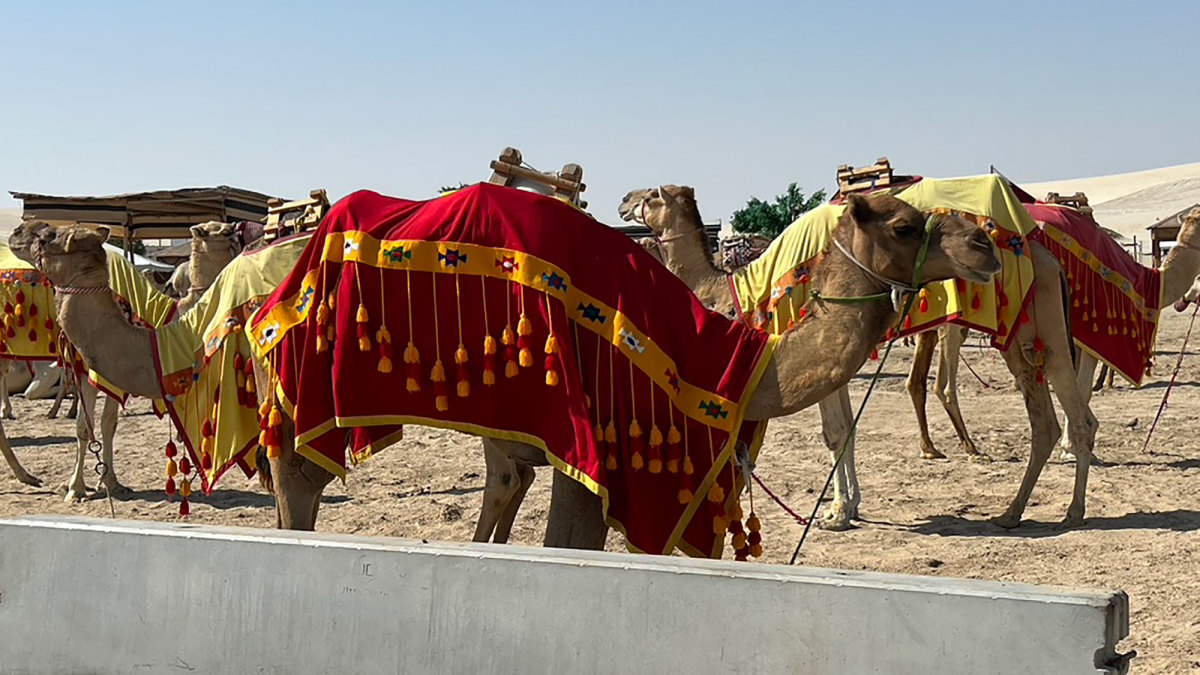
World Cup fans are starting to swing by. I meet a group from Europe decked out in thobes, the long, flowing, mostly white robes that hang from shoulder to ankle, along with ghutras, the square or rectangular headscarves. I can’t tell whether they’re intended as an homage or unintentionally disrespectful or worse. I don’t ask, because while we’re sipping tea inside a tent, looking out at the camels, they convince the easy mark to take a “safari” through the sand dunes.
The driver, Bashel, seems like a manager of sorts. He’s from Sudan. He’s smiling as he speeds up and down the dunes, the Toyota truck lurching unsteadily, as sand covers the windshield at times and the car’s tires spin incessantly at others. It isn’t exactly scary. It also isn’t not scary. The hardest part to adapt to is when he drives straight up or down what seem like 85-degree inclines—85-degree inclines of loose sand. While dancing to Arabic music, “Hotel California” and some sort of R&B jamz mix, he seamlessly slides the gear into neutral and lets the truck glide, slowly and sideways, until we reach the bottom or the top. He even finds time, as the car bounces and skims, to complain about his workplace dynamics to Pradeep, as we stumble upon something everyone in the world appears to hold in common.
On the way back, I ask him about the conditions at his job. He smiles, then says he has worked there for 10 years, and he loves it. “I’m by the ocean and the sand all day. I meet interesting people. There’s no tension,” he says, smiling and gesturing at something like his paradise.
Bashel asks, jokingly, whether his camels would be welcome to visit me in the U.S. “There is much money to be made,” he says.
Speaking of, he charges a flat fee of 300 Qatari Reals, or just over $82 for this stretch of 90 enjoyable minutes. Next week, he says, the plan is to charge $700 for the same thing, and the appointments are already almost fully booked. He doesn’t plan to watch any soccer, not with so much cash to be collected.
“This World Cup is about money,” he says with another smile that reveals a shiny capitalist’s gold tooth. “And there is money, my American friend, to be made!”
Qatar was built on oil money, built from oil money and expanded for those who all but shower in money from oil and everything else. But as Pradeep crisscrosses the rest of the country, it’s clear there’s much more to Qatar than that. He points out schools for expat business types; an eatery, Palestine Falafel Restaurant, that he swears makes the best falafel sandwich in the world; factories and farms; blocks of newly built but unoccupied homes; mansions that look like castles and occupy what seem like city blocks; places where taking photos or videos are prohibited by law; and, yes, several oil refineries looming out the window.
“This, sir, is also Qatar,” he says. “Let me show you.”
I’m all in on the tour at this point. While I sit back and ask Pradeep a thousand questions, he says we’re on Al Majd Road, once known as the Orbital Highway and the longest thoroughfare in Qatar. It extends from the Al Wakrah Municipality in the south to the Al Khor Municipality in the north. We’re headed north of there, even, to the fishing village in Al Ruwais.
Eventually, we reach the port there and pull into a small dock. Nearby, there are stacks of fishing nets wired into semicircle shapes; old, wooden boats in various stages of disrepair; and that beautiful green-blue ocean. Pradeep points to one spot near the shore, where thousands of tiny silver fish swim in shallow water, twisting and wiggling above rocks.
Most of the fish served in Doha restaurants catering to World Cup visitors will come from here, he says. This is Qatar, too.
We stop at Sea Shell Restaurant to sample the fare and other parts of this country and its culture reveal themselves, too. For one, despite our budding bromance, Pradeep repeatedly declines my invitations to join for lunch. It seems like I’m embarrassing him by asking and speaks to the cultural divide in play. For another, I’m seated upstairs, away from the locals, by myself. And, while the fish is fresh and delicious and the waiter is friendly, I’m told the mojitos on the menu are “unavailable for you.”
This is also Qatar, a country awash in contradictions and contrast, rich and poor, beautiful and harsh, a melting pot of so many different cultures. It’s like America that way—and not like America at all.
Pradeep steers the cab away from the port, toward what he says is the oldest village in Qatar, although there doesn’t seem to be a consensus online as to whether that sentiment is verifiably true. Regardless, this settlement, once home to fishermen and pearl divers before the economic boom, is breathtaking.
Only one other car is there when we arrive, and it’s easy and spooky to explore the ruins, so many crumbling brick structures through which the afternoon sun peeks through. Many are covered in graffiti and carvings from visitors, while garbage is strewn about. But that view! It’s like walking into ancient history, right next to the Gulf of Bahrain, with its rocky, muddy shore that resembles the surface of the moon.
It’s possible to climb an empty minaret, the Islamic religious towers that are typically built adjacent to mosques. They’re often used to project adhan, the Muslim call to prayer. But they’re sometimes used as landmarks, too, and World Cup types will see them all over Qatar. The landscape from the top of this minaret stretches for miles, through an opening shaped like an oversize keyhole, with rocks and dust and ruins and rotting structures and the sun gleaming off the ocean in the distance, as another day sinks into another night. It seems reasonable to wonder what the former residents of this village would think—about Doha; about how Qatar has changed, ballooned and morphed; about the World Cup, all the money, infrastructure, criticism and global implications.
Back in the cab, Pradeep points to his right. That’s Bahrain, he says, way in the distance, across the gulf. It’s also reachable by car but via a more roundabout path, roughly 272 miles away. Next, an oil refinery, smokestacks blazing far in the distance, the smoke all but dollar signs floating toward the sky. After that, a rare Maserati, what looks like part of the Trofeo Collection, zooms by so fast it’s easier to hear than see. Then, Pradeep points to a truck ahead of us, its flatbed filled with machinery and, naturally, two camels, as old and new and modern and ancient collide once more.
During a quiet moment, I ask Pradeep why he never moved his family here, or moved back to spend more time with them than the two months he takes every year. “I have always done this,” he says, meaning drive a taxi for a living, and in India it’s more competitive, for a vastly lower wage. If he moved them here—they have visited him only once—he would need to pay for an apartment by himself, which, despite many options, would be unaffordable. He must share one. Or he must move back. “I’m not an engineer,” he says.
Meaning they have their Qatar—and he has his.
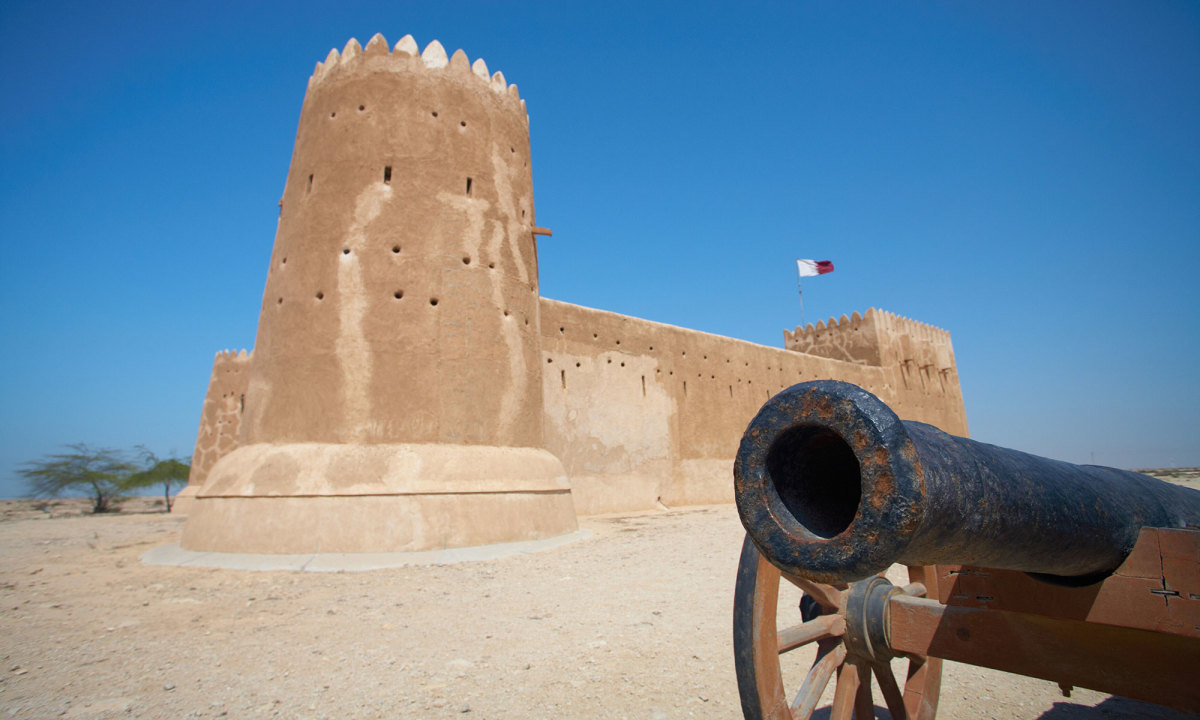
The sun drops as we park at Al Zubarah, the largest archaeological heritage site in Qatar, as tabbed by UNESCO in 2013. From the displays inside to the short film they show visitors, Al Zubarah’s purpose is to preserve and teach the country’s heritage; specifically, to showcase its roots as a trading and pearl fishing town in the Gulf region. It’s located about 62 miles north of Doha. It also seems like another world, one constructed in the mid-18th century, and yet, unlike most of the capital, it remains largely unchanged. (Well, “largely unchanged” since after the forced abandonment, which owes, according to the site, to jealousy from “other Gulf powers” over its success and several subsequent attacks that burned most of the town to the ground in 1811.) Not even 100 years later, or roughly 30 years before the first World Cup was staged in Uruguay, it was abandoned entirely.
Sixty-two miles? No. It’s more like a trip back in time, away from the World Cup and still part of it, in whatever small way.
As for the ongoing collision between what Qatar was and what it is and what it is becoming, the fort at Al Zubarah also contains a World Cup–themed gift shop. I buy a stuffed animal of the mascot, La’eeb, for my 5-year-old son and chat up the workers, all of whom came from India to find work as the economy boomed.
All plan to watch the World Cup.
None can afford a match ticket.
Upon exiting, I noticed a man sitting inside an expensive car, a black Land Rover Discovery with tinted windows, staring in my direction. He hops out and motions at me.
“My friend!”
“Yes?”
“We have heard reports in this area that someone has a drone, and that the drone might be yours.”
“No, no, no; no, sir.”
“Are you sure?”
“Absolutely.”
“On your way.”
As if he’s giving me a choice.
That’s Qatar, in all its complications, too.
There are a few more stops to make. As he drives, Pradeep wants to compare gas prices, and I explain the uptick recently in per-gallon prices in the United States. I paid more than $6 per gallon in Los Angeles a few months back. It’s cheaper here, he says, but not by that much, the price fluctuating between $0.55 and $1 per liter, with roughly four liters to the gallon. (Another universal truth uncovered! Everybody wants to complain about gas prices.)
We start to dive deeper, exploring our families and our frequent separation from them, the loneliness of the road and the burden we’re placing on our wives. To be clear, I’m not comparing my life to his; I know it’s different, easier, less time away, considerably more privileged. But, in some ways, it’s in the neighborhood of similar.
We hunt for commonalities. We both live in places—him in Doha, me outside Seattle—where everything seems to be changing, from cities to infrastructure to everyday life. The highway he’s traversing is only three years old. That great desert expanse rolling by out the window? “Fifty, 60 years ago, Doha looked like that,” he says. The sparkling, opulent, bonkers city of Lusail we stop by, home to the World Cup final next month, didn’t have a single high-rise tower when Pradeep arrived 11 years ago. Only two were even under construction.
He points to the yellow sticker affixed to his windshield. Once the soccer starts, he says, only drivers with that sticker will be allowed on Doha’s roads. That’s also Qatar, where many live one life that the majority have no access to, all inside of a country where roughly nine out of 10 people come from somewhere else. Why did it grow and change so much? “They wanted more people,” he says, “and many who came had money.”
Pradeep has driven Argentinian businessmen, a woman from Brazil who came here and stayed for 50 days while searching unsuccessfully for a World Cup ticket and even a man who told Pradeep he was from the U.S. embassy. The man hired him for the day, and, at one point, their conversation turned to alcohol, the import of which is prohibited in Qatar. Pradeep believes the concern over finding booze here has been dramatically overstated. Go to the right place, don’t get too drunk, respect the laws and culture, and everybody wins. The man from the embassy told him the Qatari government didn’t plan to arrest anyone for minor violations, hence why they created drunk pens at stadiums and have said they plan to let behavior that’s not overly obnoxious slide.
At the match Pradeep is attending, he’s planning to have “a couple” of beers. “It’s not bad here,” he says. “Trust me.”
Soon, after we make a few other stops we thank each other and promise to stay in touch. He drops me a mile from the FIFA Fan Festival, which is the closest any car can go. As I approach, it’s jarring, the contrast high as ever between Doha and the World Cup and the rest of Qatar.
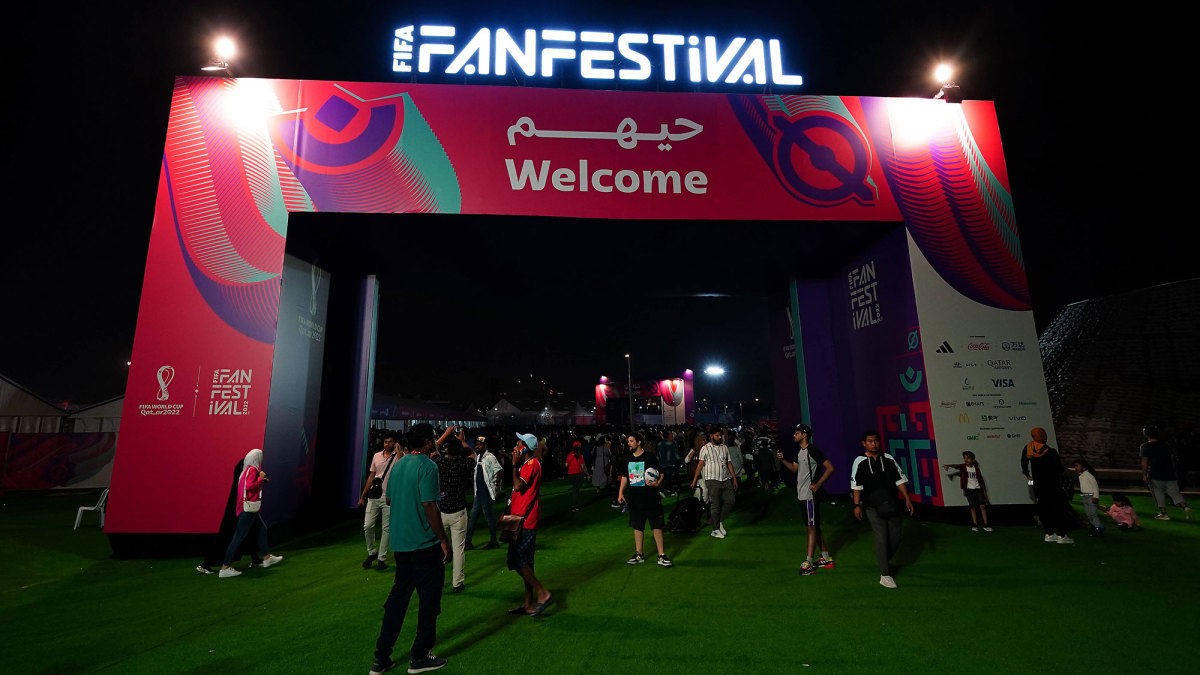
Perhaps this owes to cultural differences, but the thousands of locals and fans flooding into the festival is surprising. Onstage there’s a Michael Jackson impersonator and clusters of fans are climbing over barricades, rushing past security forces that had locked arms to form human walls and were understandably gruff and jumpy, while generally being overpowered by the more unruly fans, which, to be fair, are not the majority. It’s not a riot, and it’s not unlike crowd behavior at soccer matches in other countries.
I prefer not to remember Wednesday that way. I prefer to remember our stop by Al Bayt Stadium in Al Khor, and the walk through the adjacent park after a group of Muslim women recommended it to me while I purchased coffee from their store. The park is beautiful and all lit up, with neatly trimmed grass, new benches and artwork spreading throughout. There’s a pick-up soccer field, but no one is playing. There are families soaking in the scene, staring up at the venue, which is shaped like a tent. The only blight in sight is a McDonald’s on the premises, the long line at the drive-thru saddening.
There’s a man playing with a group of young children, aged maybe 8 or 9, and I ask whether I can videotape them briefly on my phone or take a picture, but that can be considered offensive here, and he politely says no. I start to walk away, but this man, who later declines to give his name, gestures at the ball and kicks it to me instead.
Not wanting to overstep, I play soccer with him and the kids for maybe two minutes, maybe three. In that short span, the world feels a little smaller, and Qatar, the host and the country, seems more nuanced and complex. It’s quite clearly not without its problems. But neither is America. And anyone traveling here would be wise to see all of Qatar, beyond the money and the opulence and the well-documented-and-forever-terrible mistreatment of the workers who built all that gleams and shines. Pradeep proved to at least one person that this place—and all its contradictions—are not exactly as they seem on the surface. There’s depth and beauty here, too, for anyone fortunate enough to be shown more of Qatar than a two-dimensional slice.
